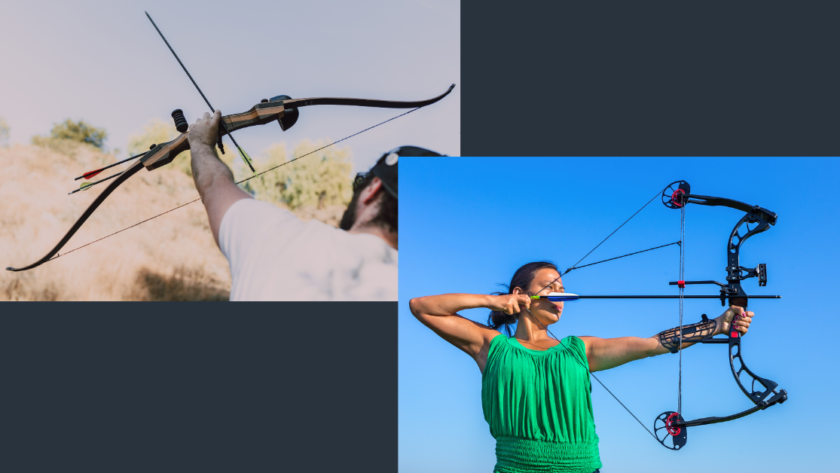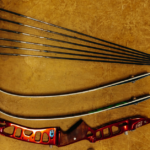Introduction
The first time I held a recurve bow, I felt a connection to centuries of archery tradition. It’s elegant simplicity spoke of skill honed through practice.
Then I picked up a compound bow, and the intricate system of cams and cables promised power and precision I’d never experienced. That moment sparked my curiosity to explore both worlds of archery.
Whether you’re an experienced archer looking to try something new or a beginner deciding which path to take, understanding the differences between recurve and compound bows is essential. Let’s compare these two types of bows to help you find your perfect match.
The Basics: Recurve vs Compound
Recurve Bows: Simplicity and Tradition
Recurve bows are the classic choice in archery. They consist of three main parts: the riser (handle), two limbs, and a string.
The limbs curve away from the archer at the tips, giving the bow it’s name and providing extra power to the shot.
The design of recurve bows hasn’t changed much over centuries. This simplicity is part of their appeal.
Many archers appreciate the direct connection between their body and the bow, feeling every nuance of the draw and release.
Compound Bows: Modern Engineering Marvel
Compound bows are a more recent invention, dating back to the 1960s. They use a system of cables and cams (wheel-like components) to create a mechanical advantage.
This design allows for greater energy storage and release, resulting in faster arrow speeds and increased accuracy.
The complexity of compound bows offers advantages like adjustable draw length and weight, making them highly customizable to person archers. However, this complexity also means more parts that need maintenance and potential repair.
Power and Performance
Raw Power
Compound bows generally have the edge when it comes to raw power. The cam system allows for a “let-off” at full draw, meaning you’re only holding a fraction of the total draw weight.
This makes it easier to aim for longer periods and can result in more consistent shots.
For example, a 70-pound compound bow might have an 80% let-off, meaning you only hold 14 pounds at full draw. This reduction in holding weight allows archers to use higher draw weights, resulting in faster arrow speeds and more kinetic energy.
Shooting Experience
Recurve bows offer a different kind of performance advantage. The simplicity of the design means fewer parts that can malfunction.
Many archers appreciate the organic feel of shooting a recurve, where success depends entirely on their skill and consistency.
Shooting a recurve needs more physical strength and stamina, especially for longer practice sessions or competitions. This can be seen as a drawback or a benefit, depending on your goals and preferences.
Arrow Speed and Energy
Compound bows typically achieve higher arrow speeds because of their mechanical advantage. A modern compound bow can easily send arrows flying at over 300 feet per second (fps).
Recurve bows, while capable of impressive speeds, generally fall in the 150-220 fps range.
Higher arrow speeds translate to flatter trajectories and more kinetic energy upon impact, which can be useful for both target archery and hunting.
Accuracy and Precision
Compound Bow Accuracy
Compound bows are often touted as more accurate, especially at longer distances. The let-off allows for steadier aiming, and the addition of sights and stabilizers can further enhance precision.
The mechanical release aids used with compound bows also contribute to consistency.
For a beginner or intermediate archer, achieving good groupings at 40 or 50 yards might be easier with a compound bow. The bow’s design helps mitigate some human errors, like slight variations in draw length or release.
Recurve Bow Accuracy
Recurve bows can be incredibly accurate in skilled hands. After all, recurve archery is the style used in the Olympics, showcasing the incredible accuracy potential of these traditional bows.
However, achieving this level of accuracy typically needs more practice and skill development.
With a recurve, every aspect of the shot process is controlled by the archer. This means that small inconsistencies in form or release can have a more significant impact on accuracy.
However, many archers find this challenge rewarding, as improvements in their technique directly translate to better performance.
The Learning Curve
The key difference in accuracy between recurve and compound bows often comes down to the learning curve. Achieving high accuracy with a recurve bow typically needs more practice and skill development.
Compound bows, with their mechanical aids, can help newer archers achieve accuracy more quickly.
However, reaching elite levels of accuracy with either bow type needs significant dedication and practice.
Versatility and Adaptability
Recurve Bow Versatility
Recurve bows shine when it comes to versatility. Their simple design makes them suitable for various archery disciplines, from target shooting to field archery and even hunting.
They’re also generally lighter and more portable, making them a great choice for archers who like to shoot in different locations or go on archery-focused travels.
Many recurve bows can be easily disassembled for transport, fitting into a compact case. This makes them ideal for backpacking trips or traveling to competitions.
Compound Bow Adaptability
Compound bows, while less versatile in terms of disciplines, offer incredible adaptability in terms of customization. You can adjust draw length, draw weight, and add various accessories to tailor the bow to your exact preferences and needs.
This adaptability makes compound bows excellent for growing archers. As your strength and skill improve, you can increase the draw weight without needing to buy a new bow.
Similarly, you can fine-tune the bow’s performance by changing out cams or adding stabilizers and sights.
Shooting Styles
Recurve bows accommodate a wider range of shooting styles. You can shoot them with fingers on the string, using various traditional and modern release techniques.
They’re also suitable for instinctive shooting, where the archer aims without sights, relying on intuition and muscle memory.
Compound bows are typically shot with a mechanical release aid, which attaches to the string and is triggered by the archer. While this limits some traditional shooting styles, it allows for extreme consistency in release, contributing to the compound bow’s accuracy potential.
The Learning Journey
Mastering the Recurve
Learning to shoot a recurve bow needs developing a strong foundation in form and technique. You’ll need to master the basics of stance, grip, anchor point, and release without the aid of mechanical advantages.
This process can be challenging and deeply rewarding.
Key skills for recurve archers include:
- Consistent draw: Pulling the string to the same anchor point every time.
- Back tension: Using the large muscles of the back to hold the draw, as opposed to just the arms.
- Clean release: Letting go of the string smoothly without disturbing the bow’s alignment.
- Follow-through: Maintaining form after the shot to ensure consistency.
Many archers find that the skills developed in recurve archery translate well to other sports and activities that need focus, body awareness, and fine motor control.
Getting Started with Compound
Compound bows, with their let-off and mechanical release aids, can be easier for beginners to pick up initially. The reduced holding weight at full draw allows new archers to focus on aiming and execution without struggling to hold the bow steady.
However, compound archery has it’s own set of skills to master, including:
- Proper draw length setup: Ensuring the bow is adjusted correctly for your body.
- Release aid technique: Learning to use a mechanical release smoothly and consistently.
- Sight adjustment: Understanding how to adjust and use multi-pin or adjustable sights.
- Let-off management: Learning to relax into the let-off without losing proper form.
Compound bows also need understanding and maintaining the complex bow system, including periodic timing and tuning of the cams and cables.
Physical Considerations
The physical demands of recurve and compound archery differ significantly. Recurve archery needs more upper body strength and endurance, as you’re holding the full draw weight throughout the aiming process.
This can be challenging for some beginners or archers with physical limitations.
Compound bows, with their let-off, are often more accessible to archers with less physical strength or certain disabilities. The reduced holding weight allows for longer aiming times and can be easier on the body during extended practice sessions.
Mental Game
Both recurve and compound archery need strong mental focus and discipline. However, the mental challenges can differ:
- Recurve archers often focus on achieving a state of “zen-like” focus, where the shot process becomes almost meditative.
- Compound archers might concentrate more on the technical aspects of the shot, fine-tuning their aim and execution.
In both cases, developing mental resilience and the ability to perform under pressure are crucial skills for competitive archers.
Maintenance and Longevity
Recurve Bow Maintenance
Recurve bows are generally easier to maintain because of their simpler design. The main maintenance tasks include:
- String replacement: Typically needed every 1-2 years for recreational archers.
- Limb alignment checks: Ensuring the limbs are properly seated and aligned.
- General cleaning: Wiping down the bow and checking for any signs of wear.
With proper care, a quality recurve bow can last for many years. The simplicity of the design means fewer things can go wrong, and when issues do arise, they’re often easier and less expensive to fix.
Compound Bow Upkeep
Compound bows, with their more complex system of cables and cams, need more regular maintenance:
- String and cable replacement: Usually needed every 2-3 years or sooner for high-volume shooters.
- Cam timing and synchronization: Periodic checks and adjustments to ensure optimal performance.
- Lubrication: Applying lubricant to axles and other moving parts.
- Accessory maintenance: Checking and maintaining sights, rest, and other add-ons.
While compound bows need more maintenance, they often have a longer functional lifespan if properly cared for. The ability to adjust draw length and weight means they can adapt as you grow or your shooting style changes, potentially serving you for many years.
Long-Term Considerations
When thinking about long-term ownership, consider:
- Availability of parts: Recurve bow parts are often standardized and widely available. Compound bow parts can be more specific to particular models and may become harder to find for older bows.
- Technological advancements: Compound bow technology evolves rapidly. While your bow won’t become obsolete, you might be tempted to upgrade more frequently to access new features.
- Resale value: Well-maintained recurve bows, especially those from reputable brands, often hold their value well. Compound bows may depreciate more quickly because of technological advancements.
Cost Considerations
Initial Investment
Initially, recurve bows are often less expensive than compound bows. A basic recurve setup suitable for beginners might cost between $150-$300, while entry-level compound bows typically start around $300-$500.
However, as you progress in your archery journey, you may find yourself investing in higher-end equipment regardless of the type you choose. High-end recurve bows used in Olympic-style competition can cost well over $1000, and top-of-the-line compound bows can reach similar prices.
Accessory Costs
The cost of accessories can significantly impact your overall investment:
- Recurve accessories: Typically include a basic sight, arrow rest, and perhaps a stabilizer. These are generally less expensive and fewer in number compared to compound accessories.
- Compound accessories: Often include more advanced sights, arrow rests, stabilizers, and a mechanical release aid. These can add several hundred dollars to your initial setup cost.
Long-Term Expenses
Consider not just the initial cost, but long-term expenses like:
- Maintenance: Compound bows generally have higher maintenance costs because of their complexity.
- Arrows: Both bow types need arrows, but compound bows often use more expensive, high-tech arrows to maximize their performance potential.
- Upgrades: As you progress, you might want to upgrade various parts of your bow. This is more common and often more expensive with compound bows.
Value Considerations
While compound bows are often more expensive, they can offer good value for certain archers:
- Longevity: The adjustability of compound bows means they can “grow” with you, potentially lasting longer before needing replacement.
- Versatility: The ability to easily switch between target archery and hunting with the same bow can provide value for archers interested in both disciplines.
Recurve bows, while simpler, offer their own value proposition:
- Skill development: The challenge of mastering a recurve can provide long-term satisfaction and transferable skills.
- Lower long-term costs: With fewer parts to maintain or upgrade, recurve bows can be less expensive over time.
Making Your Choice
Choosing between a recurve and compound bow ultimately comes down to personal preference, shooting goals, and physical capabilities. Here are some strategies to help you make your decision:
1. Try Both Types
If possible, visit an archery range that offers equipment rentals. Many pro shops also offer “test shoots” with different bow types.
Experiencing both recurve and compound bows firsthand can give you valuable insights into which feels more natural and enjoyable for you.
Pay attention to:
- How the bow feels in your hands
- The drawing and aiming process
- Your immediate comfort level with each type
2. Consider Your Primary Archery Goals
Think about what drew you to archery in the first place and what you hope to achieve:
- Traditional archery: If you’re attracted to the historical aspects of archery or want to connect with traditional shooting methods, a recurve bow might be more satisfying.
- Olympic-style target shooting: Recurve bows are used in Olympic archery. If you have dreams of competing at high levels in this discipline, starting with a recurve is essential.
- 3D archery or field archery: Both recurve and compound bows are used in these disciplines. Your choice might depend on personal preference or the specific category you want to compete in.
- Hunting: While both bow types are used for hunting, compound bows are more common because of their power and accuracy advantages.
- Casual target practice: Either bow type can be great for backyard target practice. Consider which style appeals to you more.
3. Assess Your Physical Condition
Be honest about your physical capabilities and any limitations you might have:
- Upper body strength: Recurve bows need more strength to hold at full draw. If you have limited upper body strength or certain physical limitations, a compound bow might be more comfortable.
- Stamina: Shooting a recurve for extended periods can be more tiring. If you have concerns about fatigue during long practice sessions, a compound bow’s let-off can be useful.
- Visual acuity: Compound bows typically use more advanced sighting systems, which can be helpful if you have less than perfect eyesight.
4. Evaluate Your Learning Style and Patience
Consider how you prefer to learn new skills:
- Methodical skill building: If you enjoy the process of gradually building skills and seeing incremental improvement, recurve archery might be very satisfying.
- Quick progress: If you prefer to see rapid improvement and achieve accuracy quickly, a compound bow might be more gratifying initially.
- Technical interest: If you enjoy understanding and working with mechanical systems, you might find the technical aspects of compound bows engaging.
5. Think About Your Budget
Consider both your initial budget and potential long-term costs:
- Initial investment: Determine how much you’re willing to spend on your first bow and necessary accessories.
- Upgrade path: Think about whether you’re likely to want to upgrade equipment frequently. Compound bows often have a more expensive upgrade path.
- Maintenance costs: Factor in the potential costs of maintaining each bow type over time.
6. Consider Your Available Space and Portability Needs
Think about where and how you’ll be using your bow:
- Home practice: If you have limited space for home practice, a recurve bow’s ability to be easily disassembled might be useful.
- Travel: If you plan to travel with your bow frequently, the lighter weight and simpler design of a recurve bow could be useful.
- Storage: Consider the space you have available for storing your bow and accessories when not in use.
Frequently Asked Questions
What’s the main difference between recurve and compound bows?
Recurve bows have a simple design with curved limbs and a single string, while compound bows use a system of cables and cams to provide a mechanical advantage. Compound bows typically offer more power and accuracy, while recurve bows are simpler and often preferred for traditional archery.
Which bow is better for beginners?
Both types can be suitable for beginners. Compound bows often allow new archers to achieve accuracy more quickly because of their let-off and mechanical advantages.
Recurve bows, while potentially more challenging at first, can help beginners develop fundamental archery skills.
Are compound bows more powerful than recurve bows?
Generally, yes. Compound bows can typically achieve higher draw weights and arrow speeds compared to recurve bows of similar size.
This is because of their mechanical system that stores and releases energy more efficiently.
Can you hunt with both recurve and compound bows?
Yes, both recurve and compound bows are used for hunting. Compound bows are more common in modern bowhunting because of their power and accuracy advantages, but many hunters enjoy the challenge and traditional aspect of hunting with recurve bows.
Which bow type is used in the Olympics?
Olympic archery exclusively uses recurve bows. The specific type used is called an Olympic recurve, which is a highly engineered version of the traditional recurve bow.
Are compound bows more expensive than recurve bows?
On average, yes. Compound bows tend to be more expensive because of their complex design and additional features.
However, high-end recurve bows used in competitive archery can also be quite expensive.
How often do I need to replace the string on my bow?
For recurve bows, strings typically need replacement every 1-2 years for recreational archers. Compound bow strings and cables usually last 2-3 years, but may need replacement sooner for high-volume shooters.
Can I switch from recurve to compound bow easily?
While the fundamental principles of archery stay the same, there are significant differences in technique and equipment between recurve and compound archery. Switching will need some adjustment and potentially new equipment, but many archers successfully shoot both types.
Which bow type is more customizable?
Compound bows generally offer more options for customization. You can adjust draw length, draw weight, and add various accessories like sights, stabilizers, and release aids.
Recurve bows can also be customized, but typically have fewer options.
Do I need different arrows for recurve and compound bows?
While you can use the same arrows for both bow types in some cases, compound bows often perform best with stiffer arrows because of their higher power output. It’s best to ask with an archery pro shop to ensure you’re using the right arrows for your specific bow and draw length.
Key Takeaways
- Recurve bows offer simplicity, tradition, and a direct connection to archery’s roots.
- Compound bows provide mechanical advantages, customization options, and often greater accuracy and power.
- The learning curve differs significantly between the two types, with recurves generally requiring more initial skill development.
- Consider your goals, physical capabilities, budget, and personal preferences when making your choice.
- Both recurve and compound bows can offer a rewarding archery experience with proper dedication and practice.



